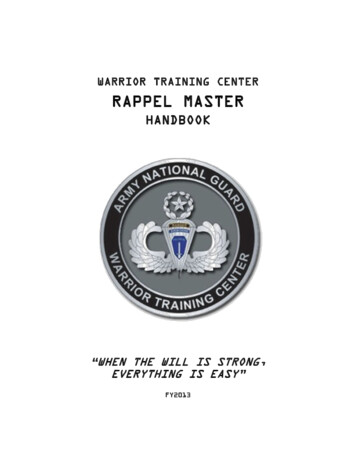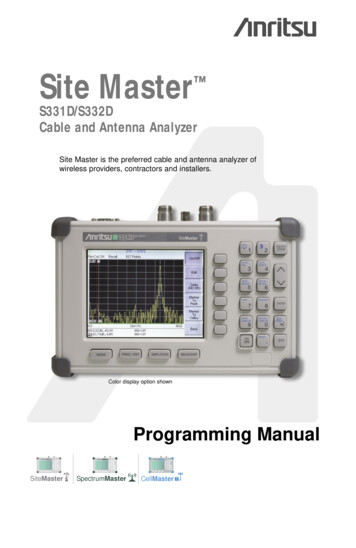
Transcription
WARRIOR TRAINING CENTERRAPPEL MASTERHANDBOOK“WHEN THE WILL IS STRONG,EVERYTHING IS EASY”FY2013
2
TABLE OF CONTENTSRAPPEL MASTER OPERATIONSCHAPTER 1DUTIES AND RESPONSIBILITIES . . .7CHAPTER 2EQUIPMENT AND ROPE MANAGEMENT . . .23CHAPTER 3KNOTS AND DEPLOYMENT BAGS . .26CHAPTER 4RAPPEL MASTER PERSONNEL INSPECTION (RMPI) .50CHAPTER 5HOOK-UP INSPECTION . 78CHAPTER 6RAPPELLING PROCEDURES. .80CHAPTER 7AIRCRAFT PREPARATION AND RIGGING. . . .88CHAPTER 8AIRCRAFT COMMAND AND CONTROL. . .963
APPENDIXAPPENDIX ATOWER INSPECTION SHEET . . .101APPENDIX BKNOT EXAMINATION (TEST) . .104APPENDIX CKNOT EXAMINATION (RE-TEST) .105APPENDIX DEQUIPMENT INSPECTION (TEST) . .106APPENDIX EEQUIPMENT INSPECTION (RE-TEST). .107APPENDIX FDA FORM 5752-R (ROPE USAGE LOG) . . .108APPENDIX GHOOK-UP EXAMINATION (TEST). . . .109APPENDIX HHOOK-UP EXAMINATION (RE-TEST) . .110APPENDIX IA/C PREPARATION AND RIGGING UH-1H (TEST).111APPENDIX JA/C PREPARATION AND RIGGING UH-1H (RE-TEST).112APPENDIX KA/C PREPARATION AND RIGGING UH-60 (TEST) .113APPENDIX LA/C PREPARATION AND RIGGING UH-60 (RE-TEST) .1144
APPENDIX CONTINUEDAPPENDIX MAIR MISSION BRIEF .115APPENDIX NAIRCRAFT COMMAND AND CONTROL (TEST) . .119APPENDIX OAIRCRAFT COMMAND AND CONTROL (RE-TEST). 1205
REFERENCESTC 21-24, Rappelling, January 2008TC 3-97.61, Military Mountaineering, July 2012(Replaced FM 3-97.61)6
CHAPTER 1DUTIES AND RESPONSIBILITIES(TOWER OPERATIONS)The static tower used may vary in size and height from 34ft to90ft. These towers should resemble the structure or aircraft of theirtraining objective. Plans and designs for static rappel towers can beobtained through the Directorate of Public Works (DPW) Engineering Division, BLDG 6, Fort Benning, Georgia 31905(706-545-1591).Rappel towers must be inspected annually by post safety or postengineers. Installations, MACOMs, and unit commanders mayestablish additional policies and safety procedures as needed toensure safe and effective rappelling operations.RAPPEL MASTER (RM):The Rappel Master’s primary responsibility is SAFETY. TheRM maintains consistent control of the operation and isresponsible for everything that happens or fails to happen. Theserviceability of all equipment (installation, unit, and personalproperty) and the personal supervision of rappelling operations arethe Rappel Master’s (RM) responsibility.RM qualification is awarded only after the successful completion of a TRADOC accredited Rappel Master course that includesthe following subjects: Duties and Responsibilities of a Rappel Master Safety SOP, regulations, and references Construction of a deployment bag Conduct of an equipment rappel off the rappel tower Conduct a Lock-In Talking a rappeller through completion of a rappel Conduct of ground training Inspecting for proper hook-ups Inspecting and maintaining equipment7
Inspecting and maintaining snap linksInspecting and maintaining rappelling glovesInspecting and maintaining rappel ropesIdentifying the rappel capabilities of aircraft usedControlling rappels from UH-1H or UH-60 aircraftTying knots (square, end-of-the-line bowline, anchorline, bowline, and Prusik), safety lines, and rappel seatsInspecting a rappel seatAircraft rigging for rappelling operationsAircraft command and controlRM’s must execute their duties in a tactical or training exerciseonce every six months to remain current. Failure to remain currentwill require a refresher class taught by a current Rappel Master onthe subjects listed above.Ground training and wall-side tower rappelling can beconducted without a school-trained Rappel Master as long as afully qualified Rappel Safety Officer (RSO) is on site to assumethe duties and responsibilities of the Rappel Master. (NOTE: TheRSO must be certified and appointed by the commander)RAPPEL SAFETY OFFICER (RSO):Must be the rank of SFC or above, trained on applicable RappelMaster tasks, and is certified by his commander to serve in theposition.Must have extensive training in rappel operations and risk management or graduate from one of the following courses: Rappel Master CourseAir Assault CourseRanger CourseBasic Military Mountaineering CourseServes as the OIC during all rappel operations and is responsible for the overall safety of all rappellers. Ensures that all safetyprecautions are followed and briefs VIPs/inspecting authorities.8
RAPPEL LANE NCO:Commander-appointed Corporal or above who is trained in thesafe and proper execution of rappelling operations. Rappel LaneNCO must be qualified to supervise their lane operations and thefollowing subjects: Responsibilities and safety requirementsInspection and maintenance of equipmentIdentification of satisfactory anchor pointsIdentification of safe and unsafe hook-upsEstablishment of a rappel pointInspection of a rappel seatCoaching techniquesRappelling proceduresEmergency proceduresBelay control proceduresSafety is their number one priority. The Rappel Lane NCO ensures proper safety procedures are followed, proper hook-ups ontheir lane, and issues commands and maintains eye contact with therappeller at all times.Note: If a Rappel Lane NCO has not conducted their dutieswithin the last six months, they must complete the training listedabove under the supervision of a current Rappel Master.RAPPELLER:The following requirements, under the supervision of a RappelMaster, must be successfully completed before beginning Aircraft(A/C) rappel training. Identify all rappelling equipmentDemonstrate construction of rappel seat; donning of rappel harness; proper use and hook-up of rappel device andrappel ropeIdentify unsafe attachments, equipment, rope connections, and seat construction9
Define terms used in rappelling operationsIdentify knots used in rappel operationsUnderstand and demonstrate rappel commandsDemonstrate rappelling positionsDemonstrate belaying proceduresDemonstrate the ability to conduct a Lock-InExhibit satisfactory performance from a rappel tower ofat least 34ft in heightNOTE: 2 rappels with equipment and weapon and 2 withoutequipment and weapon (2 rappels are conducted from the freeside of the tower) BELAY SAFETY:Must be Ranger or Air Assault qualified. One Belay Safety mustbe present for each two rappel stations.The Belay Safety ensures belay personnel are performing theirduties properly and should possess the same qualifications as aRappel Lane NCO.BELAYER:Responsibilities are a subtask of basic rappel requirements andSoldiers must be trained before conducting rappelling training.Proper belay procedures include: Assume a position at the base of the lane about one paceaway from the tower areaEnsures that the rappel ropes are even with the groundduring tower rappelsLoosely holds the rappel rope with both hands to avoidinterference with the rappeller while remaining able tostop the rappellerImmediately stops the rappeller by pulling downward onthe rappel ropes if Rappel Master shouts ―FALLING‖ orloses control of his brake hand during descentWatches the rappeller at all times and maintains constantvoice or visual contactWears a helmet to prevent injuries from falling debris10
PREPARATION AND SAFETY:The Rappel Master is in charge of the tower and conducts a visualand physical inspection of every item of equipment. This includesthe structural lumber and timber, the ladder, the platform floor, andall anchor points. (Unit SOPs will establish a specific tower inspection but for an example see Appendix A)Static towers will not be used during thunderstorms orexcessively high winds. If ice is present, or the platform is slick fromrain, rappelling will be delayed until conditions are safe.Following personnel and equipment must be present during statictower training: Two military rappel ropes for each rappel stationOne Rappel Safety Officer (RSO)One Rappel Master for each rappel siteOne Rappel Lane NCO per rappel stationOne medic with medical kit and backboardOne safety or medical evacuation vehicle with driverOne Belayer for each rope stationOne Belay Safety for each two rappel stationsSafety briefing must be conducted prior to rappel operations andmust include the following instructions: Each rappeller must secure loose clothing and equipmentRappellers climb the tower only when directed by theRM or Rappel Lane NCORappellers stay in the center of the tower until instructedto move to a rappel pointWhen using the troop ladder only three Soldiers are onthe ladder at one time and they must wait until directed tomove up by the RMAll personnel working within 3ft of the edge of the top ofthe tower must wear a restraining strap, safety ropeattached to the anchor, or safety rope attached to the rappel rope with break applied. 3FT MUST BE SECURED11
No one should lean or sit on the railing or banisters of thetowerWhen attaching the rappel rope to the snap link, rappellers pull the slack toward the anchor point (Must becheck by the Rappel Master or Rappel Lane NCO)All personnel weighing more than 200lbs will conduct astandard hook-up rappel to determine if they require afriction hook-up (Friction hook-up is created by placing an additional two ropes in the gate of the snap linkfor a total of 6 ropes)Combat equipment is positioned on the rappeller so itdoes not interfere with the brake hand and the weaponmust be slung diagonally across the back with the muzzlepointing down/opposite side of brake handHeavy duty gloves are required for all rappel trainingBallistic or safety helmets with chin straps fastened areworn during tower rappel trainingRappellers must maintain eye contact with the RM orRappel Lane NCO while receiving commands from themRappellers ensure that they have a Belayer on their ropeBelayer keeps both hands on the rope at all times and always faces the rappellerAll tower rappelling is performed with a double strand ofropeNo running is allowed on the towerNo smoking or eating is allowed near the towerAll participants who are unable to rappel, lack confidence, or refuse to rappel are reported to the RM or OICRSO and RM must be aware of the overconfidence andcarelessness of some rappellersRM ensures all personnel are tower qualified before beginning A/C rappel trainingRappel seats are tied (or harnesses donned) by Soldierand inspected by the Rappel Master before climbing thetower.Rappel seats are removed upon completion of every rappelSeats must be re-tied and re-inspected by a qualified RMor Rappel Lane NCO before subsequent rappels12
All rope stations are rigged with two anchor points(SEE FIGURE 1.1). The first anchor point is a middle-of-the-ropeknot; the second is an end-of-the-rope anchor knot. The Rappel Master removes all slack between the knots to create equal tension on theanchor points. Also, they ensure rappel ropes reach all the way to theground.FIGURE 1.1RAPPELLER PREPARATION:Each rappeller must prepare their individual clothing and equipment. Focus on the following: Secure shirt tails, loose clothing, equipment, straps, andlong hairProperly fasten all straps and ensure the helmet is inserviceable conditionWear heavy leather workman’s gloves or rappellinggloves13
Wear identification tagsLoad-bearing equipment (LBE) or load-bearing vests(LBV) should be unfastened in the front or fastenedloosely behind the back of the rappellerRucksack should be worn high and tight on the back ofthe rappeller to allow the brake hand to reach the smallof the back (Rucksack adjustment straps will be tiedacross the chest or tucked away)Sling the weapon diagonally across the back with themuzzle down/away from the brake hand sideNOTE: Failure to properly prepare rappellers could result inbodily injury or damage to equipmentRAPPELLING PROCEDURES:Friction is created by a snap link that is inserted in a sling ropeseat and fastened to the rappeller. This method provides a fasterand more controlled descent than other methods.Hip-Rappel Seat is constructed as follows (SEE FIGURE 1.2A THROUGH 1.2 O):ABFIGURE 1.2 A/B (Place the midpoint (center) of the length of thesling rope on the hip opposite the brake hand (dominant hand).14
CDEFIGURE 1.2 C/D/E (Bring the sling rope around the waist abovethe hip bone. Tie a double over-hand knot over the navel.)FGFIGURE 1.2 F/G (Let the two free ends of the sling rope fall tothe ground in front. Then, bring the two free ends of the sling ropedown between the legs and up over the buttocks ensuring that thetwo free ends do not cross.)15
HIJFIGURE 1.2 H/I/J (Pass the ends of the ropes over the rope that istied around the waist at the two points above the center of the tworear seat pockets. Grab the free end of the rope that is on the leftside of the body with the left hand, and the free end of the rope thatis on the right side of the body with the right hand. Squat downand simultaneously pull on both running ends of the ropes andstand up. Take the two running ends of the rope down the backover the waist rope from the inside. Bring the running ends backunder the ropes that are going across the buttocks. Secure both freeends of the rope and move to the opposite side of your brake hand.)KLFIGURE 1.2 K/L (Tie the two running ends with a square knotand two over-hand knots on the hip.)16
MNOFIGURE 1.2 M/N/O (Place any excess rope in the trouser pocketnear the square knot. Gate down/hook end of the snap link againstthe navel, place the end of the snap link through both sets of ropes.Rotate the snap link a half turn so the gate is facing up and willopen away from the body.)17
(HELICOPTER OPERATIONS)Helicopter rappelling can provide a means of quick insertionwith or without a Landing Zone (LZ).Personnel required for helicopter operations include the RappelMaster, the Rappel Safety Officer, the Rappellers, and theBelayers. In addition, we will discuss the duties and responsibilities of the Pilot-In-Command (PIC).RAPPEL MASTER (RM):A qualified RM is aboard each aircraft and SAFETY is theirnumber one priority. Rappel Masters are responsible for thefollowing: Ensures internal communication between the pilot andRMEnsures external communication between the A/C andthe Ground-to-Air (GTA)Inspects all equipment and uses only authorized, serviceable equipmentInspects and tests all anchor points and knots before themission startsEnsures that all rappellers receive a safety briefing andthe pilots and aircrew receive an Air Mission Brief(AMB)Ensures rappellers are rappel qualified before conducting helicopter rappellingMaintains communications with the pilot at all timesRAPPEL SAFETY OFFICER (RSO):RSO is a SFC or above who is either Air Assault or Rangerqualified. They have overall responsibility for the safety of all rappellers and ensures that all safety precautions are followed.RSO maintains communication at all times with the pilot andRM through FM radio. Alert the RM and pilot of any unsafe acts.18
RAPPELLER:In addition to the tower qualification requirements outlined onPage 8 & 9, the individual rappeller must complete advance trainingunder the supervision of a qualified RM to participate inTACTICAL helicopter rappelling operations. This includes: Satisfactorily complete three rappels from a helicopterfrom a height of 60ft (2 rappels with combat equipmentand weapon)Demonstrate confidence and proficiency in the techniques, procedures, and equipment used in rappellingfrom a helicopterKnow the rappelling equipment used in helicopter operations and any special equipment required for helicopterrappelling.BELAYER:Assigned to EACH rope and is responsible for walking the rope(removing slack from underneath the helicopter by walkingbackward with the rope as the helicopter descends to land)beneath the helicopter during the descent. Belayer ensures the ropesare not caught on the A/C skids or tires or entangled with anotherrope to ensure a safe landing.PILOT-IN-COMMAND (PIC):PIC of the aircraft has the following duties and responsibilities: Ensures that the aircrew and all non-aircrew personnelare briefed and understand their responsibilities duringrappelling operations (Includes A/C safety and action inthe event of an emergency)Ensures that the donut ring anchoring device assemblyand/or aircraft anchor points have been inspected forcompleteness and functionalityEmphasizes procedural techniques for clearing, recovery,and/or jettison of ropesA/C centered over the target with corrections from RM19
TRAINING:Sustainment training must be conducted before an element or unitcan perform helicopter rappelling. Review of the construction of a rappel seat, equipment tobe used, and hook-up proceduresConduct of two rappels on the 34ft or higher tower wall(One with equipment)Conduct two rappels from the open side of a 34ft orhigher rappel towerRefresher training must be conducted if a Soldier has not performed a helicopter rappel during the past six months. Consists ofthree satisfactory rappels from a tower, to include: One rappel with a weapon and equipmentOne rappel executing a Lock-InPREPARATION AND SAFETYMedical coverage must consist of a qualified, equipped medic torespond to any mishap. Also, medical transportation must beavailable. (Absence of a medic, medical equipment, ortransportation will terminate training)If the situation warrants, and the installation cannot support aMEDEVAC mission, the rappel aircraft may be used as CASEVACvehicle as a last resort.During helicopter rappel training, the RSO will have radio communications with the A/C. Voice communications are required before starting A/C rappelling. Additionally, the RSO will inform thePIC to stop operations if an unsafe condition develops.Rappel operations will not be conducted under the followingconditions: Ambient temperature is 30-degrees Fahrenheit or less20
Winds in excess of 30 knotsLightning strikes within one nautical mile of rappellingoperationsWind chill factors caused by the helicopter’s rotor washor extraction cruise air speeds (Cold weather injuries)Water or ice on the rope inhibiting the ability of therappellers to control their descentThe rope is exposed to the elements for a sufficient lengthof time to freeze, thereby reducing its tensile strengthBlowing particles produced by rotor wash causes the aircrew or the RM to lose visual contact with the groundThe following requirements are necessary for night rappellingoperations: One chemlight will be attached to the end of the rope andone on each rappellerOne chemlight will be secured to the attachment point ofthe ropeNight Vision Goggles (NVG’s) will not be worn by rappellers during the descent (Aircrew members will wearNVG’s as required during night operations)The following safety measures must be discussed during thesafety briefing and enforced during the operation: Loose clothing and equipment are securedHelmets are worn with chin straps fastenedRappellers wear identification tags and earplugs, carryidentification cards, and role down their sleevesWeapons are slung diagonally across the back with themuzzle pointing down on the guide hand sideAll seats and rappelling equipment must be inspected bya RM before rappellingNo running is allowed within 50ft of the A/CPersonnel approach and depart the helicopter from thefront and forward of the rear of the cargo doors(Personnel bend their bodies forward at the waist toensure clearance of the rotor blades)21
Upon boarding the A/C, the rappeller sits or kneels down,hook-ups, and applies his brake hand to the small of theirbackWhile in the helicopter, the rappeller maintains eye-toeye contact with the RM and receives commands fromthemThe rappeller ensures that they have a Belayer on theirrope at all times when conducting training at a hover siteDuring the descent, the rappeller maintains eye-toground contactIf the rappeller sees their rope coming off the ground orsees that their Belayer has lost control of their rope, therappeller immediately brakes and executes a Lock-In(Wait for commands from the RM)The rappeller brakes once every 30ft during descentBelayer does not wear gloves and keeps both hands onthe rope (Eyes on the rappeller at all times)All rappelling will be conducted using a double strand ofrope22
CHAPTER 2EQUIPMENT AND ROPE MANAGEMENTThis Chapter discusses basic equipment used for rappellingoperations, rope types, rope selection, and care procedures for eachrope type.GLOVES:The gloves are inspected for serviceability and areunserviceable if holes are found in the friction-bearing surfaces oralong the seams.UNSERVICEABLE: Broken Stitches: 3 consecutive stitches or 5 broken orloose stitches in a general areaCuts, rips, burns, or tears that show exposed skinMissing glove inserts when wearing gloves withoutfriction bearing padSNAP LINKS:Snap links are used to join equipment, rope, and people into afunctioning system. When used properly they are strong, versatileitems. Snap links are metal (steel, aluminum, or alloys) loops witha hinged, spring-loaded gate on one side. They come in many sizedshapes, and strengths (with and without locking gates), and inmany types of metal. Though the heaviest of available snap linkmetals, steel is the strongest.TYPES:1. STANDARD SNAP LINK2. LOCKING SNAP LINK Steel23
2,000 lbs with the gate closedSpring-loaded gate without locking sleeveWeight 3.9 ouncesINSPECTION: Should be inspected daily, before, during, and after use.The metal should be checked for cracks, grooves, burrs,rust, and flaws.There should be no lateral movement when the gate isopen.The gate spring action should snap shut when released.The locking notch should have a slant or slot so the gateremains shut under the impact of a rappellers fall.Gate pins should not work their way out of their holesand should not be shorter than their holes.Locking mechanism should not have stripped threadsand should lock completelyNOTE: The snap link must be boiled in water for 20 to 30 seconds to remove the cleaning agents.ROPES:Ropes are the rappeller’s most important items of equipment.They provide access down the obstacle or aerial platform whileensuring individual safety.CONSTRUCTION:1. KERMANTLE ROPE2. LAID ROPETYPES:1. STATIC ROPE2. DYNAMIC ROPE24
INSPECTION: Ropes should be inspected before and after each use,especially when working around loose rock or sharpedges (KEEP A ROPE LOG FOUND ON APPENDIXF OF THIS HANDBOOK)Check Kermantle rope by carefully inspecting how therope feels as it runs through the hands. Ensure there areno lumps or depressionsEnsure ends of the rope are either whipped and dippedor taped and burnedCheck for any cuts or frays in the rope25
CHAPTER 3KNOTS AND DEPLOYMENT BAGSThis chapter discusses rope terminology, knots, deployment ofropes, and coiling techniques.TERMINOLOGY:When using ropes, understanding basic terminology is important. Most commonly used terms in rappelling include: A BIGHT of rope is a simple bendof rope in which the rope does notcross itself A LOOP is a bend of a rope inwhich the rope crosses itselfA HALF HITCH is aloop that runs around anobject in such a manner asto lock or secure itself26
A TURN wraps around an objectproviding 360-degree contact A ROUND TURN wraps aroundan object one and one-half timesRUNNING ENDis the loose orworking end of theropeSTANDING ENDis the static, stationary, or nonworking end of therope LAY is the direction of twist used in construction of the rope PIGTAIL is the portion of the rope’s running end locatedbetween the safety knot and end of the rope DRESS is the proper arrangement of all knot parts. Removal ofunnecessary kinks, twists, and slack to ensure all rope parts ofthe knot make contact is ensured during the dress arrangement27
KNOTS:All knots used by a rappeller are divided into four classes: CLASS I: JOINING KNOTSCLASS II: ANCHOR KNOTSCLASS III: MIDDLE ROPE KNOTSCLASS IV: SPECIAL KNOTSNOTE: The following knot classes are provided as a general guideand some knots may be appropriate in more than one class.Knot tying is an important skill that can be lost if not used andpracticed. Experience/practice in tying knots, bights, bends, andhitches help the rappeller in many situations.SQUARE KNOT is used to tie the ends of two ropes of equaldiameter. Therefore, it is a Joining Knot (CLASS I). Listed beloware the steps to tying the Square Knot:STEP 1. Holding one working end in each hand, place theworking end in the right hand over the one in the left hand.STEP 2. Pull the working end under and back over the topof the rope in the left hand.STEP 3. Place the working end in the left hand over theone in the right hand and repeat STEP 2.STEP 4. Dress the knot down and secure it with anover-hand knot on each side of the Square Knot.CHECKPOINTS(1) There are two interlocking bights.(2) The running end and standing end areon the same side of the bight formed bythe other rope.(3) The running ends are parallel to and onthe same side of the standing ends with 4inminimum pigtails after the over-handsafeties are tied.28
END-LINE BOWLINE is used to tie a single fixed loop in theend of a rope. It is an Anchor Knot (CLASS II). Listed below arethe steps to tying the End-Line Bowline Knot:STEP 1. Bring the working end of the rope from right toleft (as the climber faces the anchor).STEP 2. Form an over-hand loop in the standing part of therope (on the climber’s right) toward the anchor.STEP 3. Reach through the loop and pull up a bight.STEP 4. Place the working end of the rope (on theclimber’s left) through the bight and bring it back ontoitself. Now dress the knot down.STEP 5. Form an over-hand knot with the tail from thebight.CHECKPOINTS(1) The bight is locked intoplace by a loop.(2) The short portion of thebight is on the inside of thefixed loop.(3) There is a minimum 4inpigtail after tying the overhand safety.IN-LINE BOWLINE is used to tie the end of a rope around ananchor. It is an Anchor Knot (CLASS II). Listed below are thesteps to tying the In-Line Bowline Knot:STEP 1. Bring the working end of the rope around theanchor, from right to left (as the climber faces the anchor).STEP 2. Form an over-hand loop in the standing part of therope (on the climber’s right) toward the anchor.STEP 3. Reach through the loop and pull up a bight.STEP 4. Place the working end of the rope (on theclimber’s left) through the bight and bring it back ontoitself. Now dress the knot down.STEP 5. Form an over-hand knot with the tail from thebight.29
CHECKPOINTS(1) The bight is locked into place bya loop.(2) The short portion of the bight ison the inside of the loop around theanchor.(3) There is a minimum 4in pigtailafter tying the over-hand safety.MIDDLE-OF-THE-ROPE PRUSIKis used to put a moveable rope on a fixed rope such as a Prusik ascent or a tightening system. It is a Special Knot (CLASS IV).Listed below are the steps to tying the Middle-of-the-Rope PrusikKnot:STEP 1. Double the short rope forming a bight with theworking ends even. Lay it over the long rope so the closedend of the bight is 12in below the long rope and theremaining part of the rope (working ends) are the closest tothe climber; spread the working end apart.STEP 2. Reach down through the 12in bight. Pull up bothworking ends and lay them over the long rope. Repeat thisprocess making sure the working ends pass in the middle ofthe first two wraps. Now there are four wraps and alocking bar working across them on the long rope.STEP 3. Dress the wraps and locking bar down to ensurethey are tight and not twisted. Tying an over-hand knotwith both ropes will prevent the knot from slipping duringperiods of variable tension.CHECKPOINTS(1) Four wraps with a locking bar.(2) The locking bar faces theclimber.(3) The knot is tight and dresseddown with no ropes twisted orcrossed.(4) Knot should contain an overhand knot.30
END-OF-THE-ROPE PRUSIK is used to put a moveablerope on a fixed rope such as a Prusik ascent or a tightening system.It is a Special Knot (CLASS IV). Listed below are the steps totying the End-of-the-Rope Prusik Knot:STEP 1. Using an arm’s length of rope, place it over thelong rope.STEP 2. Form a complete round turn in the rope.STEP 3. Cross over the standing part of the short rope withthe working end of the short rope.STEP 4. Lay the working end under the long rope.STEP 5. Form a complete round turn in the rope, workingback toward the middle of the knot.STEP 6. There are four wraps and a locking bar runningacross them on the long rope. Dress the wraps and lockingbar down. Ensure they are tight, parallel, and not twisted.STEP 7. Finish the knot with a bowline to ensure that thePrusik knot will not slip out during periods of varyingtension.CHECKPOINTS(1) Four wraps with a lockingbar.(2) The locking bar faces theclimber.(3) The knot is tight anddressed down with no ropestwisted or crossed.(4) Knot should contain anover-hand knot.WATER KNOT is used to attach two webbing ends. It is alsocalled a ring bend, over-hand retrace, or tape knot. It is a JoiningKnot (CLASS I). Listed below are the steps to tying the WaterKnot:STEP 1. Tie an over-hand knot in one of the ends.STEP 2. Feed the other end back through the knotfollowing the path of the first rope in reverse.31
STEP 3. Draw tight and pull all of the slack out of theknot. The remaining tails must extend at least 4in beyondthe knot in both directions.CHECKPOINTS(1) There are two over-hand knots,one retracing the other.(2) There is no slack in the knot andthe working ends come out of theknot in opposite directions.(3) There is a minimum 4in pigtail.FISHERMAN’S KNOT is used to tie two ropes of the same orapproximately the same diameter. It is a Joining Knot (CLASS I).Listed below are the steps to tying the Fisherman’s Knot:STEP 1. Tie an over-hand knot in one end of the rope.STEP 2. Pass the working end of the other rope through thefirst over-ha
HANDBOOK “WHEN THE WILL IS STRONG, . Rappel seats are removed upon completion of every rap-pel Seats must be re-tied and re-inspected by a qualified RM or Rappel Lane NCO before subsequent rappels . 13 All rope stations are rigged with two anchor points (SEE FI










